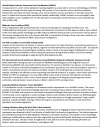Education and Training of Emergency Medical Teams: Recommendations for a Global Operational Learning Framework
- PMID: 27917306
- PMCID: PMC5104687
- DOI: 10.1371/currents.dis.292033689209611ad5e4a7a3e61520d0
Education and Training of Emergency Medical Teams: Recommendations for a Global Operational Learning Framework
Abstract
An increasing number of international emergency medical teams are deployed to assist disaster-affected populations worldwide. Since Haiti earthquake those teams have been criticised for ill adapted care, lack of preparedness in addition to not coordinating with the affected country healthcare system. The Emergency Medical Teams (EMTs) initiative, as part of the Word Health Organization's Global Health Emergency Workforce program, aims to address these shortcomings by improved EMT coordination, and mechanisms to ensure quality and accountability of national and international EMTs. An essential component to reach this goal is appropriate education and training. Multiple disaster education and training programs are available. However, most are centred on individuals' professional development rather than on the EMTs operational performance. Moreover, no common overarching or standardised training frameworks exist. In this report, an expert panel review and discuss the current approaches to disaster education and training and propose a three-step operational learning framework that could be used for EMTs globally. The proposed framework includes the following steps: 1) ensure professional competence and license to practice, 2) support adaptation of technical and non-technical professional capacities into the low-resource and emergency context and 3) prepare for an effective team performance in the field. A combination of training methodologies is also recommended, including individual theory based education, immersive simulations and team training. Agreed curriculum and open access training materials for EMTs need to be further developed, ideally through collaborative efforts between WHO, operational EMT organizations, universities, professional bodies and training agencies. Keywords: disasters; education; emergencies; global health; learning.
Figures
Similar articles
-
International Emergency Medical Teams in the Aftermath of the 2015 Nepal Earthquake.Prehosp Disaster Med. 2019 Jun;34(3):260-264. doi: 10.1017/S1049023X19004291. Epub 2019 May 6. Prehosp Disaster Med. 2019. PMID: 31057142
-
The Response by International Emergency Medical Teams Following the Beirut Harbor Explosion in 2020 - Who Were They, When Did They Arrive, What Did They Do, and Were They Needed?Prehosp Disaster Med. 2022 Aug;37(4):529-534. doi: 10.1017/S1049023X22000784. Epub 2022 May 20. Prehosp Disaster Med. 2022. PMID: 35593141 Free PMC article.
-
International Emergency Medical Teams Training Workshop Special Report.Prehosp Disaster Med. 2018 Jun;33(3):335-338. doi: 10.1017/S1049023X18000262. Epub 2018 Apr 26. Prehosp Disaster Med. 2018. PMID: 29697044
-
Pharmacy Emergency Preparedness and Response (PEPR): a proposed framework for expanding pharmacy professionals' roles and contributions to emergency preparedness and response during the COVID-19 pandemic and beyond.Res Social Adm Pharm. 2021 Jan;17(1):1967-1977. doi: 10.1016/j.sapharm.2020.04.002. Epub 2020 Apr 10. Res Social Adm Pharm. 2021. PMID: 32389631 Free PMC article. Review.
-
Paramedic Disaster Health Management Competencies: A Scoping Review.Prehosp Disaster Med. 2019 Jun;34(3):322-329. doi: 10.1017/S1049023X19004357. Epub 2019 May 28. Prehosp Disaster Med. 2019. PMID: 31134873
Cited by
-
Developing the Disaster Medical Responder's Course in Singapore.Western Pac Surveill Response J. 2023 Nov 30;14(6 Spec edition):1-6. doi: 10.5365/wpsar.2023.14.6.1009. eCollection 2023. Western Pac Surveill Response J. 2023. PMID: 38298249 Free PMC article.
-
What structural factors influencing emergency and disaster medical response teams? A comparative review study.J Educ Health Promot. 2019 Jun 27;8:110. doi: 10.4103/jehp.jehp_24_19. eCollection 2019. J Educ Health Promot. 2019. PMID: 31334262 Free PMC article. Review.
-
A review of the response and the emergency medical teams (EMTs) deployment in Armenia following an explosion at a fuel depot near Stepanakert (Nagorno-Karabakh)/ in Armenia.Confl Health. 2025 Feb 18;19(1):10. doi: 10.1186/s13031-025-00649-1. Confl Health. 2025. PMID: 39966893 Free PMC article.
-
Tailoring a national emergency medical team training package for Pacific island countries and areas.Western Pac Surveill Response J. 2023 Dec 15;14(6 Spec Ed):1-6. doi: 10.5365/wpsar.2023.14.6.1033. eCollection 2023. Western Pac Surveill Response J. 2023. PMID: 38298251 Free PMC article. No abstract available.
-
Development and preliminary validation of a public health emergency competency model for medical staffs of national health emergency teams in China.BMC Health Serv Res. 2022 Aug 13;22(1):1033. doi: 10.1186/s12913-022-08361-z. BMC Health Serv Res. 2022. PMID: 35962357 Free PMC article.
References
-
- Guha-sapir D, Hoyois P, Below R. Annual Disaster Statistical Review 2013: The numbers and trends. Centre for Research on the Epidemiology of Disasters (CRED). 2014. Available from: http://www.cred.be/sites/default/files/ADSR_2010.pdf [cited 2016 March 10]
-
- Lind K, Gerdin M, Wladis A, Westman L, von Schreeb J. Time for order in chaos! A health system framework for foreign medical teams in earthquakes. Prehosp Disaster Med. 2012 Feb;27(1):90-3. PubMed PMID:22591933. - PubMed
-
- Van Hoving DJ, Wallis LA, Docrat F, De Vries S. Haiti disaster tourism--a medical shame. Prehosp Disaster Med. 2010 May-Jun;25(3):201-2. PubMed PMID:20586008. - PubMed
-
- Kastner J. Volunteering in a disaster zone. Nurs Stand. 2015 Jun 24;29(43):64-5. PubMed PMID:26103875. - PubMed
Grants and funding
LinkOut - more resources
Full Text Sources




